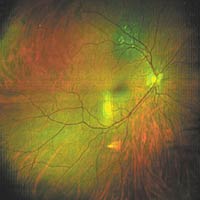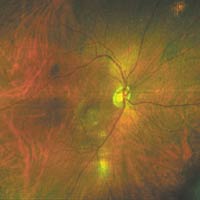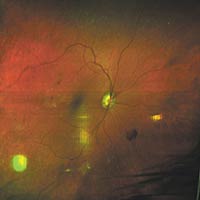Screening tool effective for assessing retinal pathology
Ophthalmologists and optometrists can screen patients and make referrals for diabetic retinopathy and other pathologies.
BOSTON — A new screening tool can detect retinal pathology through a non-mydriatic pupil as effectively as a dilated fundus exam, researchers here have found.
According to Caroline A. Baumal, MD, who used the Panoramic200 (Optos; Marlborough, Mass.) for research at the New England Eye Center (NEEC), “This [device] can be used for screening, and not just by ophthalmologists, but also by other allied health professionals such as optometrists and perhaps even primary care physicians or endocrinologists who see a lot of diabetics. It may improve the access for some patients to health care.”
According to Carmen A. Puliafito, MD, MBA, of the NEEC, the Optos Panoramic200 introduces scanning laser ophthalmoscopy technology in a screening device. The instrument takes a digital image of 200° of the retina through an undilated pupil. The image is taken in 0.25 seconds.
“This is a screening tool,” Dr. Puliafito said. “It is the year 2000 version of Helmholtz’s ophthalmoscope. It gives you high quality images. All these images can be readily transmitted by Internet technology.”
Clinical data from a double-masked comparative trial conducted at the NEEC concluded that sensitivity and specificity were comparable with standard fundus photography. Another study conducted by Andrew W. Eller, MD, at the University of Pittsburgh Eye and Ear Institute, concluded that retinal disease could be effectively screened.
Researchers and clinicians spoke about the product at a session held by Optos to introduce the Panoramic200 to attendees of the American Society of Cataract and Refractive Surgery meeting.
First unit
One year ago, Drs. Puliafito and Baumal received the first production unit made available. They immediately started to assess the device’s capabilities.
“When we initially had this machine, we were overcome by phone calls from patients who wanted to be examined without pupil dilations,” Dr. Baumal said.
The device uses red and green lasers and an elliptical mirror to obtain an ultra-wide field image on a 2,000 by 2,000 pixel screen.
The green laser obtains most of the information from the sensory retina to the pigment epithelium, while the red laser images from the pigment epithelium down through the choroid. These images can be separated for enhanced diagnostic ability. The images can be imported into other software to be archived, printed or transmitted by e-mail.
Testing protocol
In September 1999, Drs. Puliafito and Baumal started a screening protocol that enrolled all of their retinal patients who could give verbal consent and cooperate with the exam. They excluded patients with disabilities that prevented them from sitting at the Panoramic200.
All photographs were taken by a trained photographer or a technician. The staff had 5 minutes to take pictures in both eyes and were allowed five chances to capture an image, Dr. Baumal said.
Next, a technician gave dilating drops and a clinician took conventional fundus photographs.
The Panoramic200 images and conventional fundus photographs were evaluated at different times by a physician who was unaware of the patient’s diagnosis.
Panoramic200 images were classified as acceptable or unacceptable. Acceptable images were classified by how much of the retina was seen, whether it was just the macula, out to the equator or peripheral to the equator. The images were also classified based on disease category and correlated to standard fundus photographs, Dr. Baumal said.
The researchers took more than 1,500 images. For the Pathology Detection Program, they examined 86 eyes in 45 patients. Images could be evaluated for 67 eyes. The image was unreadable in 19 eyes. Patients were uncooperative for 10 eyes, the machine failed in six eyes and the patients could not fixate in three eyes.
Dr. Baumal said that the Panoramic200 had a sensitivity of 95.8% and a specificity of 100%, and missed two cases of pathology. Fundus photography had a sensitivity of 91.6% and a specificity of 100%, and missed four cases of pathology.
Diabetic screening
Dr. Eller uses the device to screen for retinal pathology for more than 4,000 diabetic patients included in his health maintenance organization plan.
“In my practice, where I spend about half of my time looking at diabetics, I thought this was pretty exciting,” he said. He received the second production unit made available.
He developed a protocol to screen patients undergoing a routine retinal evaluation.
Dr. Eller conducted a randomized study using three masked retinal specialists viewing images obtained by the Panoramic200.
Age and visual acuity were recorded from the patient work-up done on the day of imaging. The patient’s ability to follow directions, participate in the exam and remain mobile around the machine were also assessed on a scale of 1 (most difficulty) to 3 (no difficulty).
Imaging success rates were 77.4% overall and 89.4% in patients with 20/20 visual acuity, Dr. Eller said. The median mobility score was 3.
Of the 22.6% of patients with imaging failures, their median age was 70 and they had a median score of 2 on ability to follow directions. Their visual acuity ranged from 20/20 to light perception.
Retinal specialists viewed the images and assigned a quality grade on a scale of 1 to 3. The three masked retinal specialists had correlation rates of 89.7%, 86.6% and 84.4% between image and clinical diagnosis, Dr. Eller said.
Next, a subset of patients with diabetic retinopathy was introduced into the general pool of images. Masked specialists attempted to detect diabetes and grade the severity. They also suggested a timeframe for referral to an ophthalmologist.
In this scenario, the masked retinal specialists had between 79.1% and 86.9% rate of correlation between the images and diagnosis of diabetic retinopathy, Dr. Eller said.
“We feel that if this was used in a multidisciplinary diabetic clinic, higher correlation rates in all stages of retinopathy are very possible,” Dr. Eller said.
Routine referrals
The Panoramic200 also could be used by optometrists as part of routine referrals to ophthalmologists, said Donald S. Teig, OD.
He is part of a three-person optometric practice in Ridgefield, Conn., and he maintains a referral relationship with an eight-physician tertiary care ophthalmology practice. He also is heavily involved with screening and caring for professional athletes.
In these situations, he is required to perform annual checkups on players, but often is not allowed to dilate their pupils because the athletes have other performance evaluations to undergo later in the day.
He estimated that he takes between 400 and 500 images per month.
“We can put a lot of people through the testing,” he said. “We’ll do it on anyone young enough or old enough to sit still and have the test done.”
He also performs referrals with corneal refractive surgeons in the New York area. For these cases, he can e-mail the images every time he does a preoperative screening for laser in situ keratomileusis surgery.
“The surgeons we work with really appreciate being able to get that image in 5 or 10 minutes after we’ve done the preoperative testing and have it documented,” Dr. Teig said. “Referrals become extremely effective with this instrument and we can do it a lot quicker time-wise, and in a busy practice that’s a major advantage. We do dilate patients when we feel it’s a necessity, but in many cases, we won’t be dilating.”
 |  |
 | The Optos Panoramic200 introduces scanning laser ophthalmoscopy technology in a screening device. The instrument takes a digital image of 200° of the retina through an undilated pupil. The image is taken in 0.25 seconds. |
For Your Information:
- Carmen A. Puliafito, MD, MBA, and Caroline A. Baumal, MD, can be reached at the New England Eye Center, 750 Washington St., Box 450, Boston, MA 02111; (617) 636-1486; fax: (617) 636-4215.
- Andrew W. Eller, MD, can be reached at the University of Pittsburgh Eye and Ear Institute, 203 Lothrop St., Pittsburgh, PA 15213; (412) 647-2208; fax: (412) 647-9607.
- Donald S. Teig, OD, can be reached at the Institute for Sports Vision, 96 Danbury Road, Ridgefield, CT 06877-4053; (203) 438-5855; fax: (203) 431-0318. Dr. Teig has no direct financial interest in any of the products mentioned in this article, nor is he a paid consultant for any companies mentioned.
- Optos North American Headquarters can be reached at 199 Forest St., Marlborough, MA 01752; (508) 486-9303; fax: (508) 486-9310.
